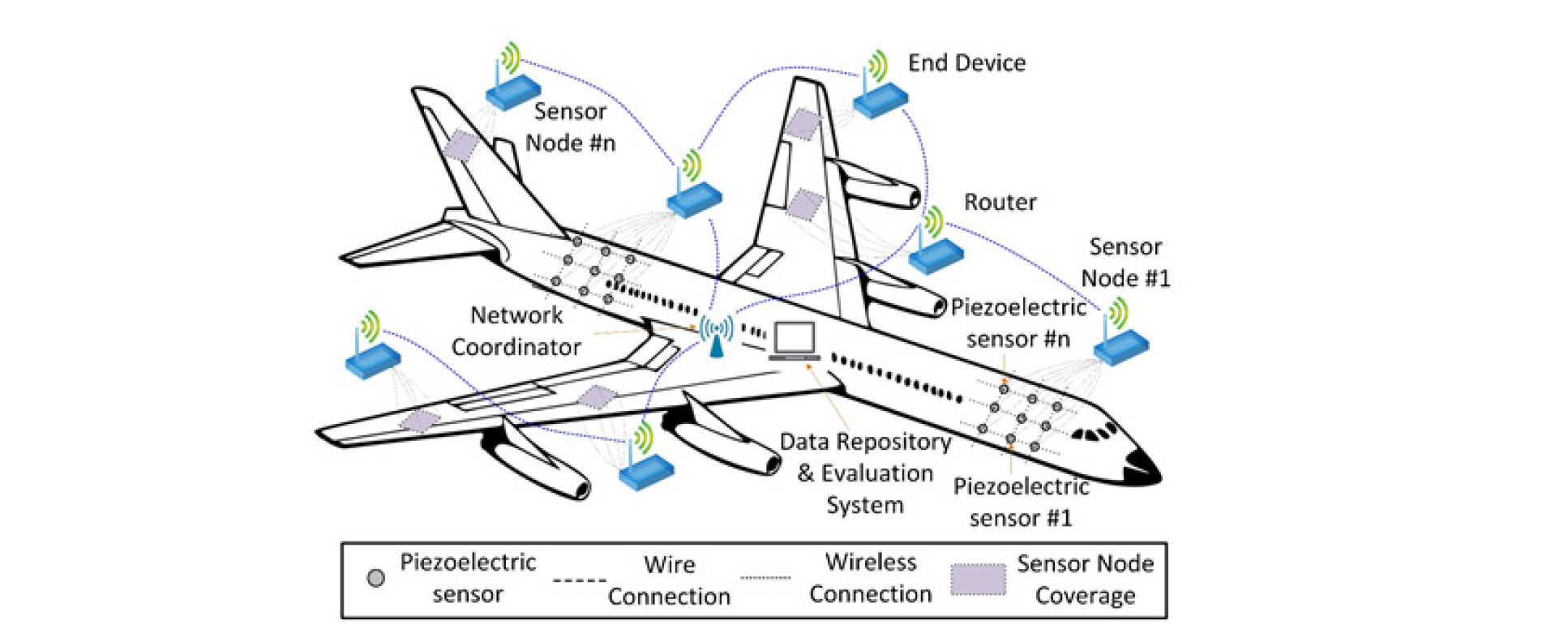Life-cycle Assessment of Complex Structures
Structural Health Monitoring (SHM) is an emerging technology covering the development and implementation of technologies and methodologies for monitoring, inspection and damage assessment based on integrated sensors. The acquired data in combination with advanced signal processing techniques can provide maintenance actions upon demand.
Our group has been at the forefront of recent developments for detecting impact events and damage localization for complex composite structures. Supported through several European Projects (SMASH, SCOPE, SARISTU) and a recent Cleansky II, core-partner project SHERLOC with a budget of €9.6M we are leading a team of European Industries and Research Institutions to take several SHM technologies (PZT, FO, Hybrid) to industrialization through the building block approach.
 The challenges for development of methodologies and technologies which we are adressing include:
The challenges for development of methodologies and technologies which we are adressing include:
- High reliability and probability of detection under operational conditions;
- Applicable to complex structures such as curved composite stiffened panel;
- Self-diagnostic function to detect faulty sensors;
- Possibility of repair and/or replacing the sensors without any damage to the structure;
- Minimum interference with the functionality of the host structure and minimum additional weight.
Selected Publications:
- Book: A. Salehzadeh Nobari and M.H. Ferri aliabadi, "Vibration-based Techniques For Damage Detection And Localization In Engineering Structures", World Scientific Publishing, 2018
- Book: M.H. Ferri aliabadi, and Z. Sharif Khodaei, "Structural Health Monitoring for Advanced Composite Structures Computational and Experimental Methods in Structures", Volume 8. 2018: World Scientific Publishing Europe Ltd. 288.
Structural health Monitoring Paradigm
Active Sensing: Damage Localization
Composites are prone to impact damage resulting in delamination and /or fibre breakage. Current practice of detecting damage categorised as Barely Visible Impact Damage (BVID) includes inspecting structures for surface dents of up to 0.2mm depth or a more elaborate non-destructive inspection approach during maintenance. The surface dents tend to be inconsistent depending on the mass of the impactor and as the result composites are design much thicker than strictly necessary.
Our research has shown the use of sensors on panels can provide the information we need to reduce the maintenance costs and weight while increasing/maintaining safety. One way to do this is by detecting BVID in the structure, the design of the composite can be less conservative and weigh savings can be achieved.
Passive Sensing: Detecting Critical Impact Events
Engineering structures such as Aircraft experience impact by foreign objects routinely during their normal operation. Uncertainties related to frequency of impact and its likelihood to cause damage have resulted in utilization of thicker composites (i.e. heavier parts) than strictly necessary. Through the combination of advanced Machine Learning Techniques, non-linear Finite Element and Experimental Measurements we have developed a Passive SHM system capable of predicting the impact location with almost pinpoint accuracy and more importantly discriminating between the event s (energies, impact forces) that are likely to cause BVID and others below the critical threshold.
By combining novel impact detection methodology and signal processing with an Innovative Microelectronic technology we have developed a passive SHM system that is small and light enough to be placed permanently on-board of an aircraft and record critical impact events likely to cause damage. The PMCU system being the first ever technology of its kind (Patent pending) can be interrogated wirelessly by engineers on ground or on-board as required.
Wireless active sensing technology
A wireless compact active sensing unit has been designed by our group for data acquisition and equiped with energy harvesting capabilities. The design of the WiAct module has been optimized to achieve certain required optimum operative features. The innovative features which makes the system attractive for application to large-scale structures in operation, are:
- Low-power consumption: 81.7 µA – sleep mode 53 mA – active mode
- Multiple sensing channel: 8 (up to 24)
- Wireless communication: 60 m indoor
- Battery-powered system: AA battery
- Low channel cross-talk
- Miniaturized in dimension: 80 mm × 65 mm
- High sampling rate: 1.8 Msps for Sensing; 5.3 Msps for Actuating
- Multiple operation mode: Sleep/Active
- Energy harvesting
Selected Publications:
H Fu, Z Sharif-Khodaei, MHF Aliabadi, An energy-efficient cyber-physical system for wireless on-board aircraft structural health monitoring, Mechanical systems and signal processing 128, 352-368, https://doi.org/10.1016/j.ymssp.2019.03.050
Wireless passive sensing technology
Our group have designed a novel on-board wireless passive sensing system for impact detection of composite airframe. The WiPas system, the first of its kind, offers an invaluable tool for monitoring impact events on critical structures. The unit is battery operated and light, therefore it can remain on-board of an aircraft .
Several modules, including filtering, impact detection, local processing and wireless transmission modules have been specifically designed and evaluated for detecting rare, random and transitory impact events. An event-triggered mechanism with high responsiveness is adopted to reduce the system power and to maintain the detection effectiveness. This design allows the system to be adaptive, energy-efficient and highly responsive to impacts. This innovative system provides a low-power, high-responsiveness passive on-board sensing system.

Selected Publications:
Hailing Fu, Zahra Sharif Khodaei and M.H. Ferri Aliabadi, „An Event-Triggered Energy-Efficient Wireless Structural Health Monitoring System for Impact Detection in Composite Airframes“, IEEE Internet of Things Journal 2018, DOI 10.1109/JIOT.2018.2867722.


